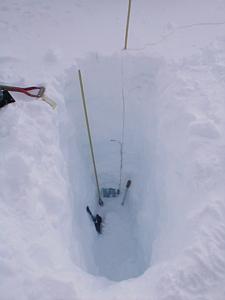6 December, 2000
Launching Hobos
In order to reconstruct the climate going back several thousand years, Gary
Clow needs a precise temperature profile from the base to the surface of
the ice sheet. The temperature logs from the main borehole reach from the
base at 1000 meters up to 70 meters. The four shallow boreholes provide the
temperatures for the top section of the ice and firn. However, the
temperature curve for the top 20 meters is not smooth. This is due to
seasonal temperature differences.
Summer and winter temperatures at Siple Dome vary by about 30 degrees
Celsius (54F). These differences diffuse slowly down through the firn. They
are visible in the temperature data to a depth of about 20 meters. In order
to smooth out the temperature curve, the average or mean annual temperature
of the surface snow must be determined. This will provide information about
the climate for the last 50 to 100 years.
Finding the mean annual temperature involves recording or logging the
temperature of the surface for one year. Setting up this part of the
project has been my responsibility. We have five instruments for recording
temperature. They are called Hobo temperature loggers. I learned how to use
them when I visited Gary in Colorado last June.
A computer is used to start or "launch" the data loggers. They can record
temperatures many times a day for up to several years. Temperature data is
obtained inside the unit and at a sensor on the end of a six-foot wire.
This allows you to record temperatures at different snow depths. We decided
to place the Hobos at a depth of two meters with the external sensor at one
meter.
A depth of two meters was chosen because the Hobo battery is only rated to
a temperature of -30C (-22F). At this depth, the temperature should not
drop below that point. I also constructed blocks of insulating foam to
surround the instrument.
I placed a unit at each of the four drill sites. An additional Hobo was put
in at 32km south with the sensor at a depth of three meters. Sarah Das also
installed four Hobo loggers. So we have one temperature logger about every
10 km (6mi) from 30km north to 40km south. In addition to providing the
mean annual surface temperature, the data will also provide information
about climate variability across Siple Dome.
When Gary Clow and Bob Hawley return next year for the project's final
season, they will be able to dig up the Hobo units and download the
temperature data that will have been collected for an entire year.

A. The Hobo temperature logger is about the size of a hockey puck. It is on the right, sitting on the foam container. A serial cable is plugged into the Hobo's data port in order to launch the unit or to download data. Here I have downloaded some test data to the laptop.

B. I'm digging one of the two-meter (6.5ft) snow pits used to install the temperature loggers. Digging a snow pit is actually fun and it is a good way to stay warm.

C. The foam box containing the Hobo is at the two-meter depth in the snow pit. The wire with the external sensor extends up to the one-meter level. An attached cord goes up to the surface where it is tied to a marker pole. This will aid the recovery of the unit next year.
Contact the TEA in the field at
.
If you cannot connect through your browser, copy the
TEA's e-mail address in the "To:" line of
your favorite e-mail package.
|
